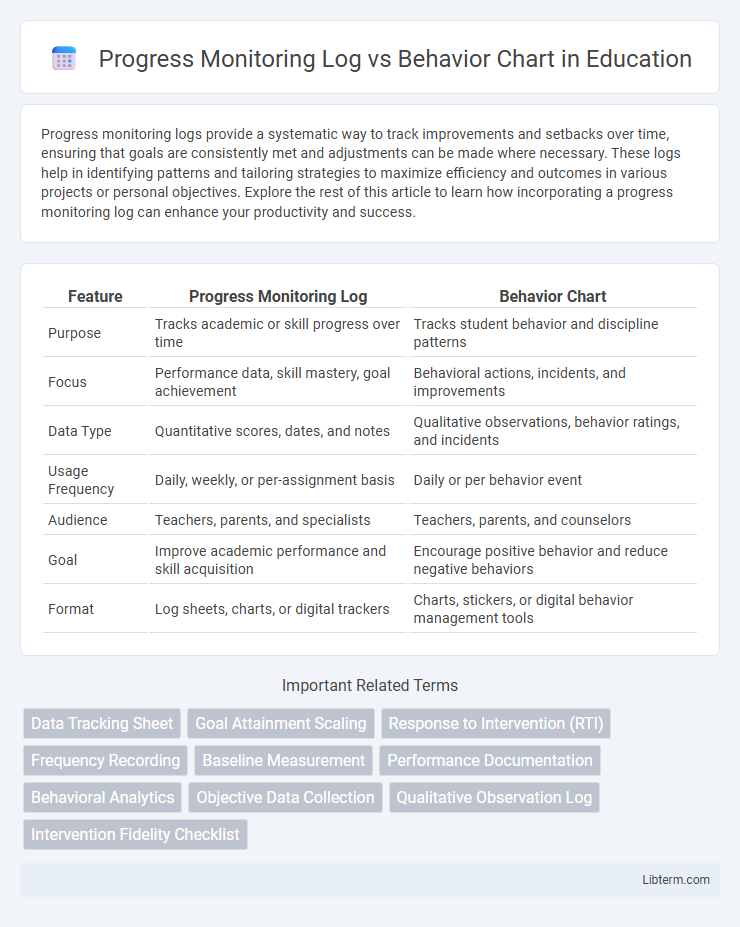Progress monitoring logs provide a systematic way to track improvements and setbacks over time, ensuring that goals are consistently met and adjustments can be made where necessary. These logs help in identifying patterns and tailoring strategies to maximize efficiency and outcomes in various projects or personal objectives. Explore the rest of this article to learn how incorporating a progress monitoring log can enhance your productivity and success.
Table of Comparison
| Feature | Progress Monitoring Log | Behavior Chart |
|---|---|---|
| Purpose | Tracks academic or skill progress over time | Tracks student behavior and discipline patterns |
| Focus | Performance data, skill mastery, goal achievement | Behavioral actions, incidents, and improvements |
| Data Type | Quantitative scores, dates, and notes | Qualitative observations, behavior ratings, and incidents |
| Usage Frequency | Daily, weekly, or per-assignment basis | Daily or per behavior event |
| Audience | Teachers, parents, and specialists | Teachers, parents, and counselors |
| Goal | Improve academic performance and skill acquisition | Encourage positive behavior and reduce negative behaviors |
| Format | Log sheets, charts, or digital trackers | Charts, stickers, or digital behavior management tools |
Introduction to Progress Monitoring Logs and Behavior Charts
Progress Monitoring Logs systematically track student performance data over time, providing detailed insights into academic progress and intervention effectiveness. Behavior Charts visually represent behavioral patterns, helping educators and parents identify trends and reinforce positive behaviors through immediate feedback. Both tools are essential for data-driven decision-making in educational settings, facilitating targeted support tailored to individual student needs.
Key Differences Between Progress Monitoring Logs and Behavior Charts
Progress monitoring logs track specific academic or skill-based progress by recording measurable data points over time, providing objective evidence of improvement or decline. Behavior charts focus on tracking behavioral patterns, using visual cues and reinforcement strategies to encourage positive habits and reduce negative actions. The key difference lies in their purpose and data type: progress monitoring logs quantify performance metrics, while behavior charts emphasize behavioral modification through consistent observation and feedback.
Purpose and Goals: Progress Monitoring Log vs Behavior Chart
A Progress Monitoring Log is designed to systematically track a student's academic performance or skill development over time, helping educators identify trends and adjust instruction to meet learning goals. A Behavior Chart specifically targets the observation and modification of behavioral patterns, aiming to reinforce positive actions and reduce negative conduct through visual feedback and goal setting. Both tools support individualized interventions, but the Progress Monitoring Log emphasizes academic progress, while the Behavior Chart focuses on behavioral improvements.
Data Collection Methods in Both Tools
Progress Monitoring Logs utilize quantitative data collection methods such as checklists, rating scales, and frequency counts to track student performance over time, enabling objective measurement of academic or behavioral progress. Behavior Charts primarily employ visual data collection techniques including daily marks, stickers, or color-coded systems to provide immediate feedback on specific behaviors, facilitating real-time behavior modification. Both tools benefit from consistent, systematic data recording to ensure accurate monitoring and effective intervention planning.
Advantages of Using Progress Monitoring Logs
Progress monitoring logs provide detailed, continuous data that allows educators to track student performance and growth over time with precision. These logs enable individualized goal setting and adjustments based on specific academic or behavioral metrics, improving intervention effectiveness. The ability to document quantitative progress supports data-driven decision-making and communicates progress clearly to students, parents, and team members.
Benefits of Implementing Behavior Charts
Behavior charts provide clear, visual feedback that enhances student self-awareness and motivates positive behavior changes. They facilitate consistent communication between educators and parents, enabling targeted interventions based on observable patterns. Implementing behavior charts supports classroom management by promoting accountability and reinforcing desired behaviors effectively.
Situations Best Suited for Progress Monitoring Logs
Progress monitoring logs are best suited for situations requiring detailed tracking of academic skills, such as reading fluency, math problem-solving, or individualized learning goals. They provide precise data over time, enabling educators to identify trends and adjust instruction for students with specific learning disabilities or those participating in Response to Intervention (RTI) programs. Unlike behavior charts that focus on social or behavioral goals, progress monitoring logs emphasize measurable academic outcomes and skill development.
When to Use a Behavior Chart for Student Success
Behavior charts are most effective when tracking specific behavioral goals and reinforcing positive actions in students who benefit from visual reminders and immediate feedback. They work well in classrooms needing consistent behavior management, especially for young learners or those with attention challenges. Progress monitoring logs complement behavior charts by providing detailed records of behavioral patterns over time, supporting data-driven interventions.
Integrating Both Tools for Maximum Impact
Integrating a Progress Monitoring Log with a Behavior Chart enhances data accuracy and provides a comprehensive view of a student's academic performance and behavior patterns. Combining quantitative progress tracking with qualitative behavioral observations enables educators to tailor interventions more effectively, ensuring targeted support. Utilizing both tools simultaneously fosters collaborative communication among teachers, parents, and specialists, driving improved student outcomes.
Choosing the Right Method: Factors to Consider
Selecting between a Progress Monitoring Log and a Behavior Chart depends on the specific goals of tracking, such as skill acquisition versus behavior modification. For academic or skill development, a Progress Monitoring Log offers detailed, quantitative data to assess growth over time, while a Behavior Chart provides visual cues that can motivate immediate behavioral changes. Consider factors like the child's age, the complexity of the behavior or skill, and the required frequency of tracking to make an informed decision that supports effective intervention and progress evaluation.
Progress Monitoring Log Infographic

 libterm.com
libterm.com